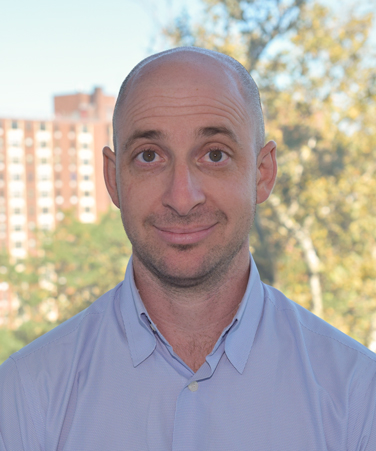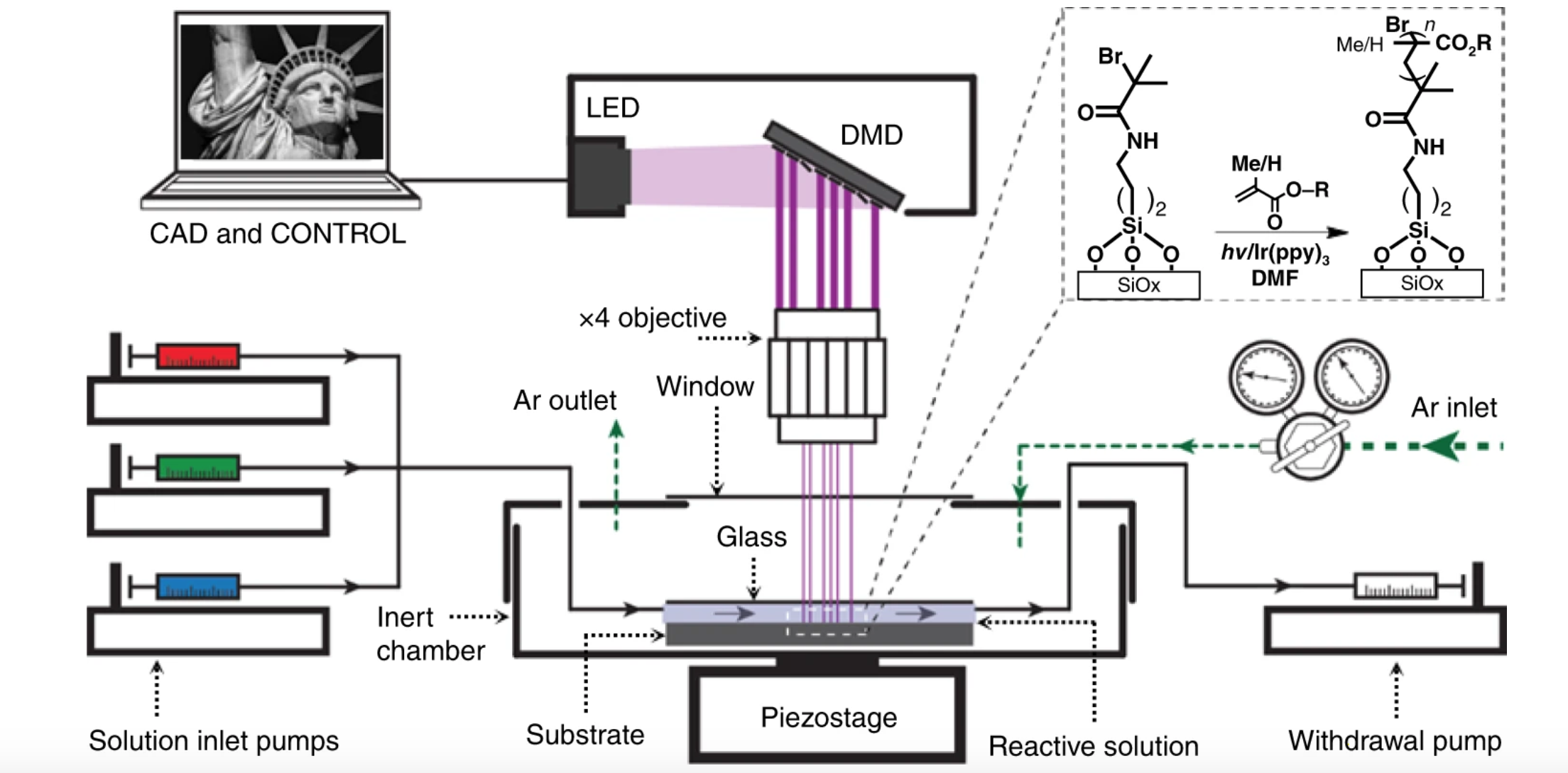Nanoscale 4D Printing Technique Recreates Cell Surfaces: Polymer Brush Hypersurface Photolithography
While 3D printing is helping humanity in creating some of the most perplexing constructs we could ever imagine, researchers are now delving into the intricate technology of 4D printing to understand the complexity of nature. We have seen how experts have applied this technology in medicine, industrial applications and even in the film industry, by going one step further and using special materials and external stimuli to make a 3D construct shapeshift over time. In early March, researches at the Advanced Science Research Center (ASRC) at The Graduate Center of The City University of New York (CUNY) and Northwestern University have created a 4D printer capable of constructing patterned surfaces that recreate the complexity of cell surfaces.
As explained in a paper published in Nature Communications, the printing method, called Polymer Brush Hypersurface Photolithography, allows scientists to combine organic chemistry, surface science, and nanolithography to construct precisely designed nanopatterned surfaces that are decorated with delicate organic or biological molecules.
The authors suggest that “polymer brush patterns have a central role in established and emerging research disciplines, from microarrays and smart surfaces to tissue engineering. The properties of these patterned surfaces are dependent on monomer composition, polymer height, and brush distribution across the surface.” According to the ASRC, the novel system overcomes a number of limitations present in other biomaterial printing techniques, for example, there is no current lithographic method capable of adjusting each of the variables of these patterned surfaces independently and with micrometer-scale resolution.
Nonetheless, thanks to the combination of microfluidics, organic photochemistry, and advanced nanolithography, researchers were able to create a mask-free printer capable of preparing multiplexed arrays of delicate organic and biological matter. So, the technique allows researchers to create 4D objects with precisely structured matter and tailored chemical composition at each voxel, a capability the authors refer to as “hypersurface lithography”.
The surfaces will have a wide variety of uses, including drug research, biosensor development, and advanced optics. The authors claim that what is most important about this technology is that it can create surfaces with different materials and that these materials can be patterned across the surface without the use of expensive photomasks (a commonly used opaque plate in photolithography with transparencies that allow light to shine through) or tedious cleanroom processes.
The study’s primary investigator and associate professor of nanoscience at CUNY ASRC, Adam Braunschweig, said “I am often asked if I’ve used this instrument to print a specific chemical or prepare a particular system. My response is that we’ve created a new tool for performing organic chemistry on surfaces, and its usage and application are only limited by the imagination of the user and their knowledge of organic chemistry.”
Braunschweig’s research interests include organic surface chemistry, as well as methodology and development of instrumentation for 4D organic nanolithography. In this paper, the organic chemistry expert addresses a huge challenge in surface chemistry (a field that studies chemical reactions at interfaces). Apparently, the team of researchers indicated that controlling the morphology and chemical composition of interfaces with micrometer-scale precision is a key challenge, with repercussions from biology to optics and material science.
The new technique produces polymeric pixels by combining a digital micromirror device (DMD), an air-free reaction chamber, and microfluidics to independently control monomer composition and polymer height of each pixel. The customized printer was built upon a TERA Print E series instrument, which coordinates the DMD, light source, and the piezoelectric stage with a CPU interface to project patterns taken from an uploaded image file onto a substrate. And, as stated in the paper, “the printer capabilities are demonstrated by preparing patterns from combinatorial polymer and block copolymer brushes.”
Daniel Valles, a doctoral student in Braunschweig’s lab at CUNY’s Graduate Center and co-author of the paper, considered that “researchers have been working toward using lithographic techniques to pattern surfaces with biomolecules, but to date we haven’t developed a system sophisticated enough to construct something as complicated as a cell surface. We envision using this system to assemble synthetic cells that allow researchers to replicate and understand the interactions that occur on living cells, which will lead to the rapid development of medicines and other bioinspired technologies.”
As a proof-of-concept, the researchers printed polymer brush patterns using precise doses of light to control the polymer height at each pixel. As illustrated by the Lady Liberty image, coordination between the microfluidics and the light source control the chemical composition at each pixel.
“Polymer chemistry provides such a powerful set of tools, and innovations in polymer chemistry have been major drivers of technology throughout the last century,” said the paper’s co-author and professor of Chemistry, Materials Science, Engineering, and Biomedical Engineering at Northwestern University, Nathan Gianneschi. “This work extends this innovation to the interfaces where arbitrary structures can be made in a highly controlled way, and in a way that allows us to characterize what we have made and to generalize it to other polymers.”
The researchers conclude that “the integration of microfluidics and an air-free reaction chamber with the DMD is the key innovation that allows the spatiotemporally controlled grafting of different materials onto the substrate, and could, in principle, be used to make polymer patterns composed of a practically unlimited number of unique brush compositions.”
Furthermore, the researchers plan to continue the development of this novel printing platform to increase system speed, reduce pixel dimensions, and develop new chemistries for increasing the scope of materials that can be patterned. Currently, they are using the patterns created by this platform to understand the subtle interactions that dictate recognition in biological systems. But ultimately, they envision a new era of soft lithography where the fabrication of synthetic surfaces with a complexity comparable to what is found in biological interfaces will soon become a reality.
Supported by funding from the National Science Foundation (NSF), the U.S. Department of Defense through a Multidisciplinary University Research Initiative, and the U.S. Air Force Office of Science Research, this investigation could broadly advance disciplines like chemistry, material science, and biology, and be applied from microarrays to modeling, as well as useful for understanding interactions of polymers with cells, bacteria, and viruses.
Subscribe to Our Email Newsletter
Stay up-to-date on all the latest news from the 3D printing industry and receive information and offers from third party vendors.
You May Also Like
Further Understanding of 3D Printing Design at ADDITIV Design World
ADDITIV is back once again! This time, the virtual platform for additive manufacturing will be holding the first-ever edition of ADDITIV Design World on May 23rd from 9:00 AM –...
3D Printer Maker EVO-tech Reborn as NEVO3D — Once More With Feeling
EVO-tech was a 3D printing service and original equipment manufacturer established in 2013 and based in Schörfling am Attersee, Austria. The company produced high-quality material extrusion systems featuring linear bearings,...
3D Systems Brings 3D Printed PEEK Cranial Implant to the U.S. with FDA Clearance
For more than 10 years, 3D Systems (NYSE:DDD) has worked hand-in-hand with surgeons to plan over 150,000 patient-specific cases, and develop more than two million instruments and implants from its...
CDFAM Returns to Berlin for Second Annual Symposium
The second CDFAM Computational Design Symposium is scheduled for May 7-8, 2024, in Berlin, and will convene leading experts in computational design across all scales. Building upon the first event...


































